Embarking on a project without a comprehensive understanding of its timeline can be compared to venturing into uncharted territories without a map. Having an effective project timeline in place not only helps us to monitor and track progress, but also aids in predicting the potential challenges ahead, making the navigation through the project smoother and more efficient.
In this article, we'll delve into what a project timeline is and elucidate the significant benefits it brings to a project's management. Besides, the detailed guide on creating a project timeline will be included. Let’s delve in!
What Is a Project Timeline
A project timeline is a crucial component of project management that offers a visual representation of tasks or activities lined up against time. In essence, it is a schedule of events or a chronology of tasks to be accomplished within specific, predefined timeframes.
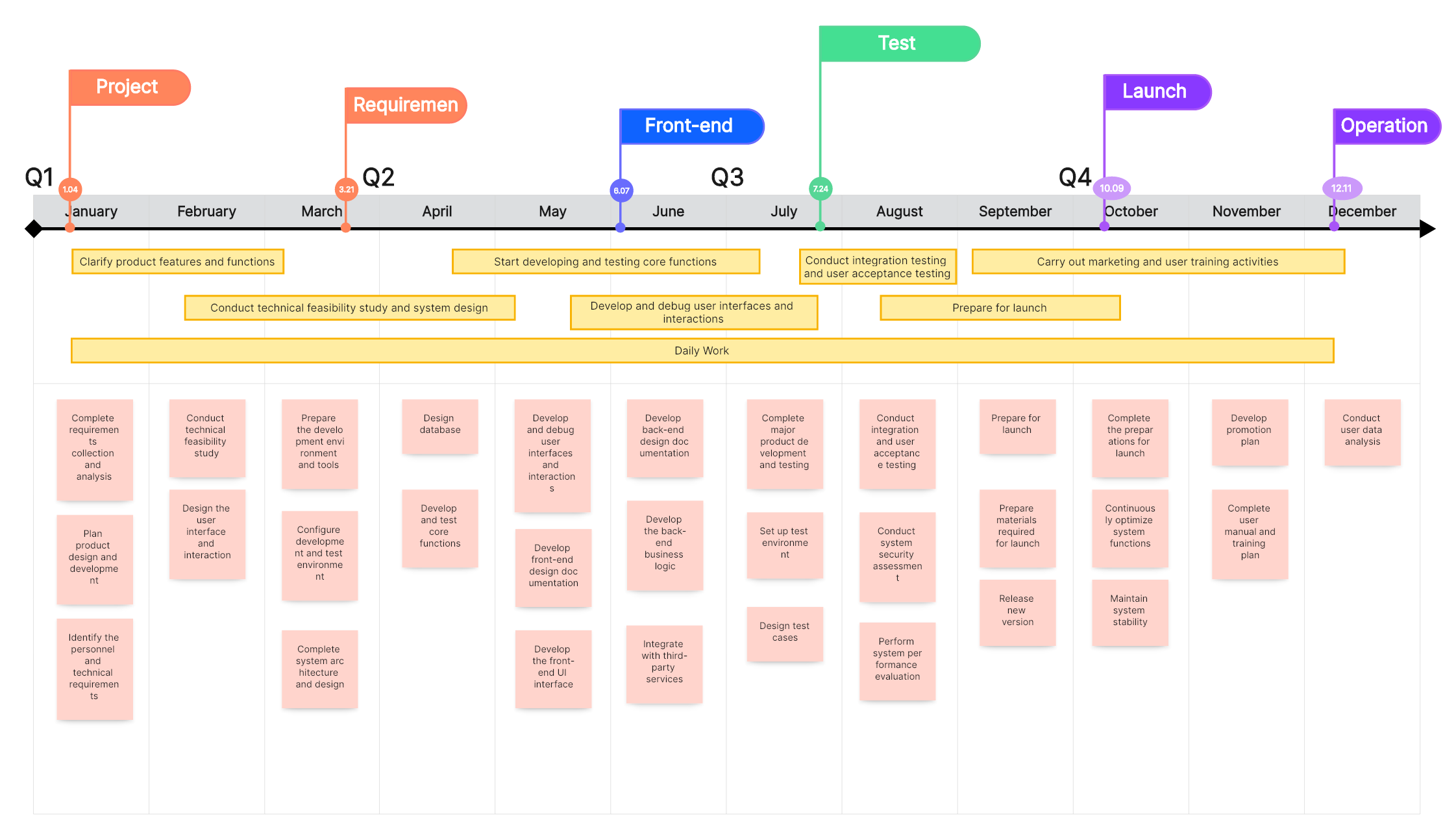
This tool includes a clear start and end date for the entire project and each of its constituent tasks. Each task is plotted against a timescale that allows stakeholders to grasp the sequence of events, durations, dependencies, and overlapping tasks, if any. A well-constructed project timeline elucidates the order in which tasks need to be completed and the resources necessary for each phase, providing all team members with a clear, cohesive roadmap to adhere to.
What to Include in the Project Timeline
Creating an effective project timeline is not just about listing tasks and deadlines. It's about incorporating all the necessary components to ensure seamless execution and monitoring of the project. Here are some essential elements that should be included in a project timeline:
- List of Tasks: The first step is to identify all the tasks that need to be performed to complete the project. This can be done through brainstorming sessions with your team or by analyzing similar past projects.
- Task Dependencies: It is critical to understand how tasks are related. Some tasks can't begin until a previous one is completed, while others can occur concurrently. Identifying these dependencies will help in structuring the timeline effectively.
- Assigned Resources: Each task should have a clear allocation of resources - both human and material. Indicate who is responsible for each task and what resources they'll need to accomplish it.
- Start and End Dates: Every task should have a clearly defined start date and deadline. This will keep everyone aware of their time limits and help manage workflow efficiently.
- Milestones: These are significant points or stages in the project that help gauge progress. Including them in your timeline will give your team something tangible to work towards and celebrate when achieved.
- Potential Risks and Buffer Time: It's important to factor in potential risks and delays that may disrupt your project timeline. Incorporating buffer time will help manage these unforeseen circumstances and keep the project on track.
Types of Project Timelines
In project management, timelines are essential tools used to outline the scope and sequence of various tasks. These chronological diagrams can vary in complexity, detail, and design based on the nature of the project. Here, we will discuss some common types of project timelines:
Gantt Charts
Possibly the most popular and widely-used type of project timeline is the Gantt Chart. Developed by Henry Gantt in the 20th century, these horizontal bar charts visually represent a project schedule. Each task is marked by a horizontal bar, its length corresponding to the duration of the task. The chart's strength lies in its ability to showcase task dependencies clearly.

Image from Wiki
Gantt Charts offer a quick overview of the project’s start and end dates, duration of individual tasks, overlapping tasks, and how they fit together in terms of sequence and timing.
Milestone Timelines
As the name suggests, milestone timelines focus on significant events or milestones within a project. They offer a high-level view of project progress, marking key points that indicate when a particular group of tasks has been completed. This type of timeline is especially useful when dealing with stakeholders or team members who need to know about the project's critical stages without delving into intricate task details.

Linear Timelines
Linear timelines provide a straightforward and simplified visual representation of a project’s timeline. On this timeline, tasks are usually presented as markers along a line that represents time, flowing from left (project start) to right (project end). This format is best suited for simple projects with few tasks and dependencies.

Agile Timelines
Agile timelines are dynamic and flexible, designed to adapt to changes as the project evolves. Typically used in Agile or Scrum methodologies, this type of timeline does not have definite end dates for individual tasks but operates in "sprints" or iterations instead.
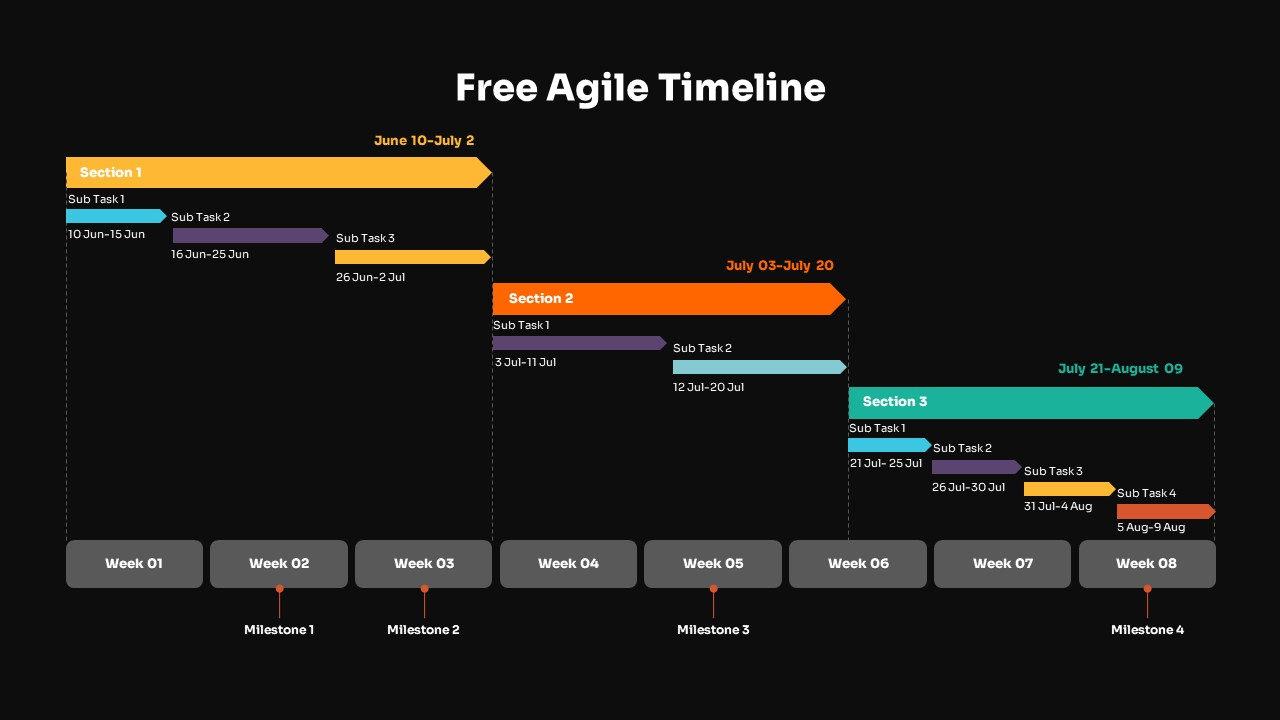
Image from SlideBazaar
In Agile timelines, the emphasis is on adapting to changes and delivering value at the end of each sprint. Tasks can be reprioritized or reestimated based on evolving project needs.
Critical Path Method (CPM) Timelines
The Critical Path Method is an algorithm used to schedule a set of project activities. A CPM timeline includes all the tasks necessary to complete a project, identifies the time duration for each task, and recognizes dependent tasks.
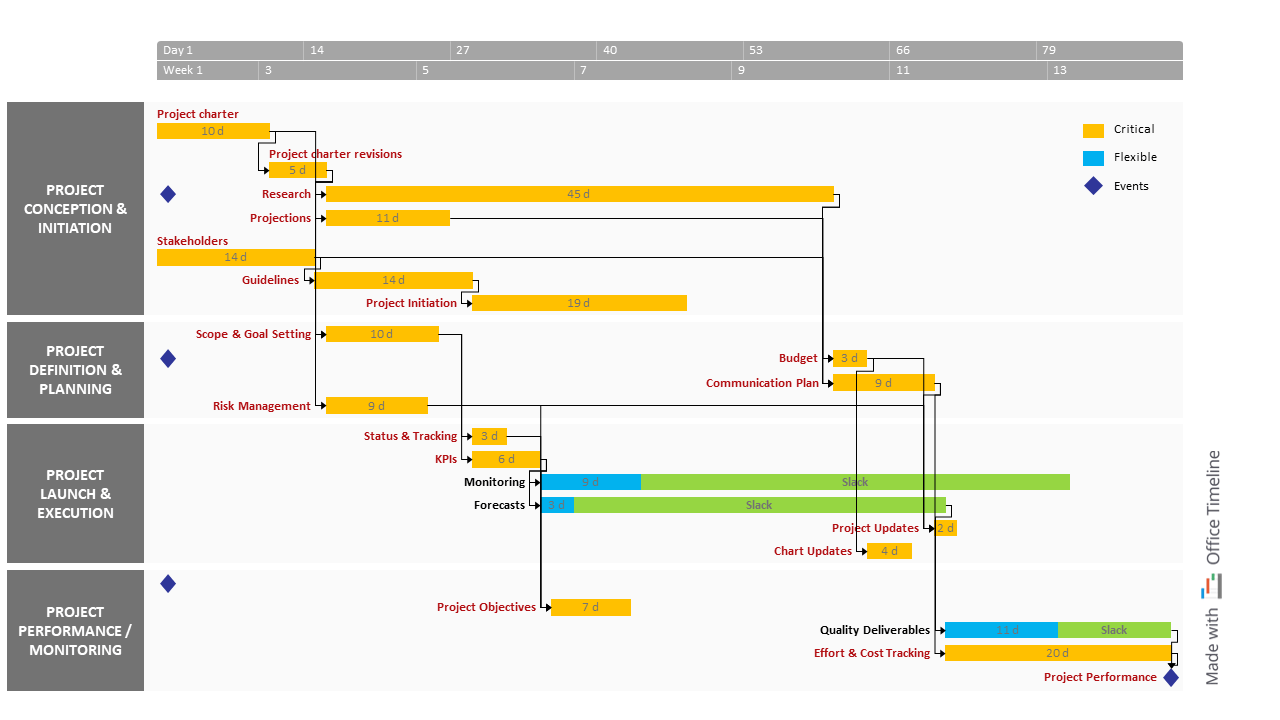
Image from Office Timeline
In a CPM timeline, the critical path is highlighted – it represents the longest stretch of dependent activities and dictates the shortest time possible to complete the project.
Each type of timeline carries unique strengths and is suited to different kinds of projects. Selecting an appropriate timeline is crucial to ensure effective scheduling and successful project management.
Benefits of a Project Timeline
Using a project timeline holds immense value for the entire project management process. It contributes significantly towards maintaining an organized approach, allowing teams to work more coherently towards their objectives.
Here are some notable benefits of utilizing a project timeline:
- Enhanced Clarity and Understanding: With all tasks laid out sequentially against a time scale, teams can understand what needs to be done and when. This clarity can minimize confusion and maximize productivity.
- Resource Allocation: A comprehensive timeline helps identify resource requirements for each task ahead of time, enabling more effective utilization of available resources.
- Better Task Sequencing: Timelines help in understanding task dependencies. Teams can schedule tasks in an optimized order, ensuring that prerequisite tasks are completed before dependent ones begin.
- Improved Communication: A visual timeline serves as a universal reference point for all team members and stakeholders. It streamlines communication by making information on progress and delays easily accessible.
- Time Management: By setting clear deadlines for tasks, timelines enable teams to manage their time better, thereby boosting efficiency and productivity.
- Tracking Progress: Project timelines serve as an effective tool for tracking progress. Teams can refer back to the timeline to gauge whether they're on track or falling behind schedule.
How to Create a Project Timeline in Minutes
Navigating through a project without an organized timeline is like setting sail without a compass. To ensure your project reaches its destination on time, you need an effective project management tool to keep track of tasks, deadlines, and milestones. A great tool that offers a fast and user-friendly solution to create project timelines is Boardmix.

Boardmix is a cloud-based, intuitive project timeline creator that enables teams to plan, manage, and track projects efficiently. With a user-friendly interface and interactive visual planning capabilities, Boardmix turns complex project data into easily digestible, visual timelines.
Boardmix provides various features including drag-and-drop functionality for tasks, ability to display task dependencies, track progress, and assign roles. Furthermore, it facilitates real-time collaboration and offers a central place where team members can communicate, discuss issues, and share files. Using Boardmix, you can create project timelines within minutes and update them in real-time as the project progresses. This flexibility makes Boardmix an excellent tool for both small-scale and large-scale projects.
Creating a project timeline in Boardmix is a straightforward process that can be done in a few simple steps:
Step 1: Create a New Board
First, sign in to your Boardmix account. Navigate to the homepage and click on "New Board."

Step 2: Define Your Tasks
A blank canvas will be opened, navigate to the "Templates" tab and search timeline templates offered by Boardmix. Then you can start defining the tasks required for your project. Be as specific as possible - name each task, provide a brief description if needed, and assign the task to a team member using the Kanban board.
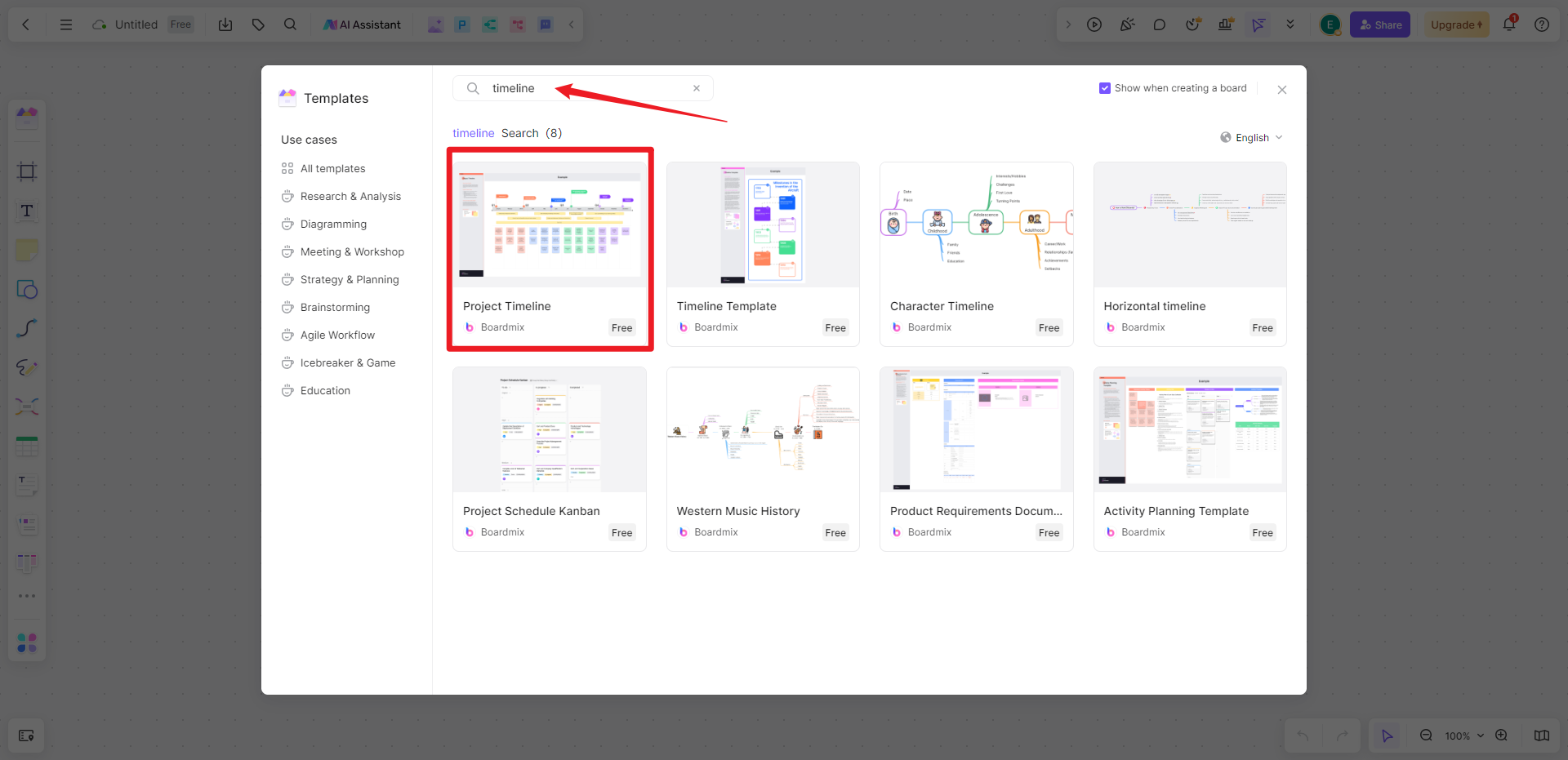
Step 3: Set Task Durations and Dependencies
Assign start and end dates for each task based on how long you expect each to take. If certain tasks depend on others, make sure to link them appropriately in the system.
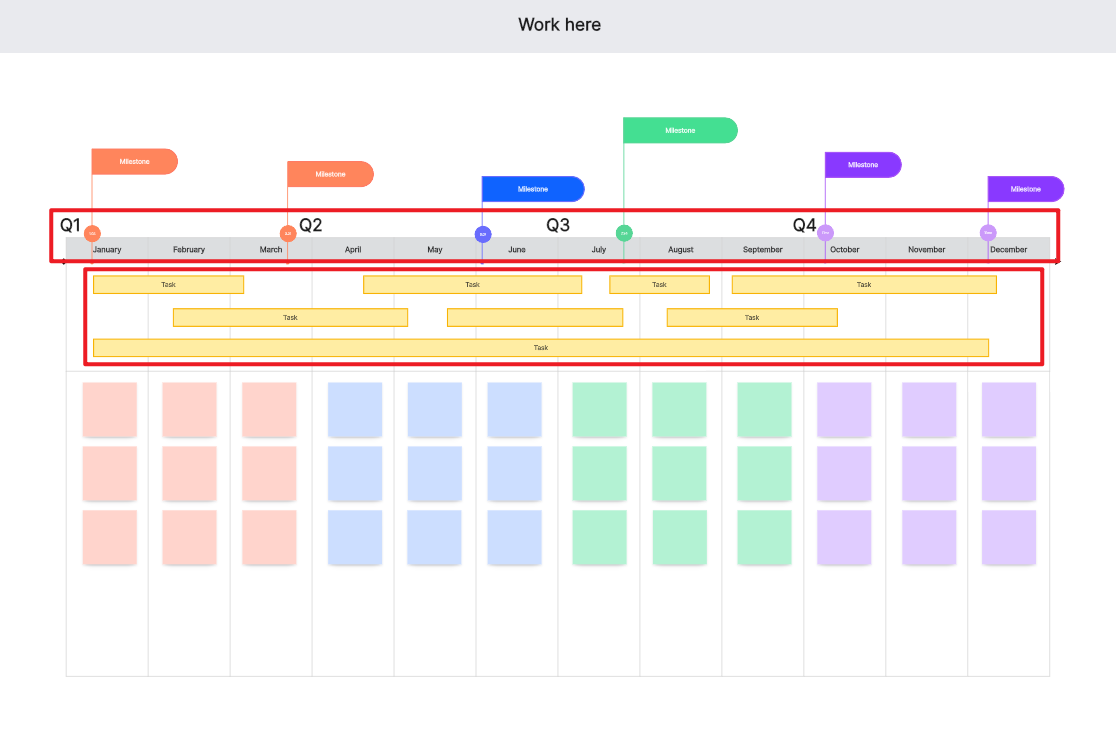
Step 4: Add Milestones
Break down your project into significant stages or milestones and add these into your timeline. These will serve as checkpoints to track your progress.

Step 5: Finalize and Share Your Timeline
Review your timeline for any potential conflicts or missing components. Once finalized, you can share the timeline with your team and other stakeholders right from the Boardmix platform.

With Boardmix, creating an accurate and comprehensive project timeline doesn't have to be a tedious process. By spending just a few minutes on this intuitive platform, you can set your project up for success from the start.
Best Practices When Estimating the Time Line in a Project
A project timeline is a key component of project planning. It illustrates the sequence of tasks, their duration, and how they relate to one another. But estimating the time line in a project accurately can be challenging. Misestimations can lead to missed deadlines, cost overruns, and frustrated teams. So, what can you do to improve the accuracy of your project timeline estimates? Here are some best practices:
- Break Down the Project Into Smaller Tasks
Divide your project into manageable, smaller tasks. It's often challenging to estimate accurately for a large, complex task. Breaking it down into smaller parts makes estimation more manageable and increases accuracy.
- Use a Reliable Estimation Technique
There are several time estimation techniques you can choose from, such as parametric estimating (based on statistical relationships), analogous estimating (based on past similar projects), and three-point estimating (using optimistic, pessimistic, and most likely estimates). The choice of technique will depend on the nature of your project and the data available.
- Involve the Entire Team
Those who will perform the tasks have the best understanding of what is involved in completing them. Therefore, include them in the estimation process to ensure that the estimates are realistic and comprehensive.
- Consider Dependencies and Constraints
The relationship between tasks (dependencies) and restrictions (constraints) can significantly impact your project timeline. Identify these early and factor them into your timeline estimation.
- Buffer for Risks and Uncertainties
Unexpected events occur in all projects, causing delays and disruptions. Identify potential risks and uncertainties ahead of time, then add buffer times into your timeline to accommodate these unknowns.
- Use Historical Data
If you have completed similar projects in the past, use the actual data from these projects to inform your estimates. Historical data provides evidence-based insights that increase the accuracy of your timeline estimation.
- Review and Adjust Regularly
As your project progresses, things change, and you gain more insights. Review your timeline regularly and adjust it based on actual performance and new information.
Estimating a project timeline is an art as much as a science. It involves a balance of accurate prediction and flexible adaptation to reality. By adhering to these best practices, you will be better equipped to create realistic and achievable project timelines that set your projects up for success.













